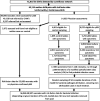Risk factors for community-acquired bacterial infection among young infants in South Asia: a longitudinal cohort study with nested case-control analysis
- PMID: 36319031
- PMCID: PMC9628539
- DOI: 10.1136/bmjgh-2022-009706
Risk factors for community-acquired bacterial infection among young infants in South Asia: a longitudinal cohort study with nested case-control analysis
Abstract
Objective: Risk factors predisposing infants to community-acquired bacterial infections during the first 2 months of life are poorly understood in South Asia. Identifying risk factors for infection could lead to improved preventive measures and antibiotic stewardship.
Methods: Five sites in Bangladesh, India and Pakistan enrolled mother-child pairs via population-based pregnancy surveillance by community health workers. Medical, sociodemographic and epidemiological risk factor data were collected. Young infants aged 0-59 days with signs of possible serious bacterial infection (pSBI) and age-matched controls provided blood and respiratory specimens that were analysed by blood culture and real-time PCR. These tests were used to build a Bayesian partial latent class model (PLCM) capable of attributing the probable cause of each infant's infection in the ANISA study. The collected risk factors from all mother-child pairs were classified and analysed against the PLCM using bivariate and stepwise logistic multivariable regression modelling to determine risk factors of probable bacterial infection.
Results: Among 63 114 infants born, 14 655 were assessed and 6022 had signs of pSBI; of these, 81% (4859) provided blood samples for culture, 71% (4216) provided blood samples for quantitative PCR (qPCR) and 86% (5209) provided respiratory qPCR samples. Risk factors associated with bacterial-attributed infections included: low (relative risk (RR) 1.73, 95% credible interval (CrI) 1.42 to 2.11) and very low birth weight (RR 5.77, 95% CrI 3.73 to 8.94), male sex (RR 1.27, 95% CrI 1.07 to 1.52), breathing problems at birth (RR 2.50, 95% CrI 1.96 to 3.18), premature rupture of membranes (PROMs) (RR 1.27, 95% CrI 1.03 to 1.58) and being in the lowest three socioeconomic status quintiles (first RR 1.52, 95% CrI 1.07 to 2.16; second RR 1.41, 95% CrI 1.00 to 1.97; third RR 1.42, 95% CrI 1.01 to 1.99).
Conclusion: Distinct risk factors: birth weight, male sex, breathing problems at birth and PROM were significantly associated with the development of bacterial sepsis across South Asian community settings, supporting refined clinical discernment and targeted use of antimicrobials.
Keywords: child health; cohort study; infections, diseases, disorders, injuries; paediatrics.
© Author(s) (or their employer(s)) 2022. Re-use permitted under CC BY. Published by BMJ.
Conflict of interest statement
Competing interests: None declared.
Figures
References
-
- Sharrow D, Hug L, Liu Y. Levels & trends in child mortality report 2020. Estimates developed by the UN inter-agency group for child mortality estimation. United Nations Inter-Agency Group for Child Mortality Estimation (UNIGME), 2020.
Publication types
MeSH terms
Grants and funding
LinkOut - more resources
Full Text Sources
Medical

